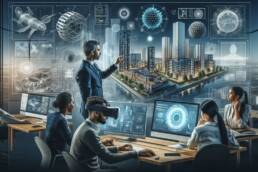In our rapidly advancing digital age, the line between the tangible world and the creations of our imagination is becoming ever more indistinct. Mastery of 3D visualization is no longer confined to the realms of game designers and film producers; it has become a crucial skill across various industries, revolutionizing the way we interpret data, design products, and tell stories.
Embarking on a Creative Quest
Imagine wielding the power to build universes that abide by your rules, where the impossible is made possible, and the limits of reality are merely a starting point. That’s the core of 3D visualization mastery. It’s a craft that demands technical expertise, an artist’s vision, and a storyteller’s passion.
The Transformation of Vision into Reality
This journey isn’t about the mere creation of pretty pictures. It’s about learning to translate complex ideas into compelling visual narratives that engage, inform, and inspire. Whether it’s visualizing the intricate details of architectural wonders before the first stone is laid or creating immersive experiences that transport the audience to uncharted territories, 3D visualization mastery is your canvas for the extraordinary.
The Art of Possible
As we embrace the potential of this powerful medium, we open doors to new forms of communication and expression. It is a tool that has become indispensable for educators, scientists, marketers, and creators. By mastering 3D visualization, we can craft new realities, breathe life into the abstract, and visualize the yet unseen. It’s a transformative process that converts the nebulous mists of imagination into concrete, interactive experiences.
Join the Vanguard of Digital Creators
By delving into the world of 3D visualization, you join a vanguard of digital creators who push the envelope of what’s possible. Whether in virtual reality, simulation training, or cinematic visual effects, the skills you develop as you master this craft are limited only by the breadth of your curiosity and the extent of your ambition.
So, embark on this journey of 3D visualization mastery, where each project is an adventure, each challenge is a lesson, and each creation is a step towards a future where our digital and physical realities are inextricably intertwined.
A. Unveiling 3D Visualization Mastery
1. Understanding the Essence of 3D Visualization
What exactly do we mean when we talk about 3D Visualization Mastery? It’s much more than just an ability to create digital models. This mastery represents a profound depth of knowledge and skill in bringing three-dimensional creations to life on a screen. It’s about understanding the interplay of light and shadow, the subtleties of texture and color, and the movement that breathes life into still objects. It’s the skill that enables architects to visualize buildings long before they’re built and animators to create worlds limited only by their imagination.
2. Becoming a Digital Sculptor
With 3D visualization mastery, you are both the architect and the builder of your digital domains. You have the power to sculpt intricate details into your models, shaping them like a potter would with clay—except your creations can be anything from fantastical beasts to sleek, futuristic vehicles. Each vertex, edge, and face in your model is a decision, a stroke of digital paint on a canvas that spans the breadth of your computer screen.
3. Lifelike Textures and Realistic Lighting
But modeling is just the skeleton; it’s the textures that are the skin and the lighting that is the soul. When you master the art of texturing, you give your models a surface that can tell a story by itself. Is it worn and battered by the elements, or is it sleek and untouched? Lighting is what takes these textured models and paints the scene with moods and atmospheres. It’s the difference between a cold, eerie moonlit night and the warm embrace of a firelit room.
4. Animation
Then comes animation—the delicate art of movement. Mastery in this sphere turns static models into actors on a stage, each with its roles and choreographies. From the subtle sway of leaves in a gentle breeze to the expressive gestures of a human face, the animation is where inanimate pixels come to dance. With this mastery, you become the puppeteer, able to orchestrate complex movements that mimic the natural world or craft fantastical motions that defy gravity.
5. Why Aim for Mastery?
Why should one aim for mastery in 3D visualization? Because it’s not just about acquiring a skill—it’s about achieving a level of proficiency that allows you to manifest ideas into visual narratives seamlessly. It’s the difference between speaking a language and weaving poetry. Mastery means being able to tackle complex problems, whether it’s in conveying the intricate design of a product or creating educational simulations that offer immersive learning experiences.
6. The Path to Mastery
The path to 3D visualization mastery is not linear. It is filled with challenges and requires dedication, patience, and a passion for continuous learning. It’s a commitment to understanding not just the how, but the why. Why does a certain texture feel real? Why does a particular animation evoke emotion? Why does lighting transform the mood of a scene?
In striving for mastery, you commit to a journey of not just technical learning but also of artistic growth. It’s about refining your skills until your hands and mind can translate visions into digital reality effortlessly. It’s about becoming a creator who can not only visualize but also innovate and push the boundaries of what’s possible in digital art.
B. The Alchemy of Textures and Lighting
Transforming basic 3D structures into compelling visual experiences requires a keen understanding of textures and lighting—two crucial components that bring a model to life. Together, they are like the alchemy of 3D visualization, turning the leaden raw models into golden lifelike images.

1. Diving Deep into the World of Textures
When we talk about the role of textures, we’re diving into the very skin of the digital world. Textures do more than just cover a surface; they communicate the material’s character. Imagine the coarse ruggedness of an old tree’s bark or the slick wetness of rain-soaked streets. These are not just visual cues but tactile experiences that textures bring to a flat screen.
Mastering textures is akin to mastering the senses. With intricate textures, you can almost feel the coolness of metal, the fuzziness of a sweater, or the sticky residue on a chewed piece of gum. The art of illusion in textures is about tricking the mind into believing, if just for a second, that the digital world is as rich and varied as the one outside the window.
2. The Artistic Science of Lighting
Lighting, on the other hand, is the magic that gives depth to these textures. It is both an art and a science. Artists use lighting to sculpt scenes in the virtual space, creating depth, highlighting focal points, and setting the rhythm of the viewer’s gaze. In the hands of a master, lighting is a storyteller. It whispers secrets in the shadows, trumpets grandeur with bright beams, and paints entire narratives with hues and highlights.
But it’s not just about the placement of lights or choosing the right colors. To truly master lighting is to understand how light behaves—how it bounces off surfaces, how it scatters through a foggy morning, how it filters through leaves, and how it dances with the time of day. It’s about simulating the physics of light while also bending it to the will of your creative vision.
Good lighting can transform a mundane scene into a visual feast, or a dramatic moment into a memorable one. It works in tandem with textures to define the look and feel of the environment you’re creating. Is it a sterile laboratory with harsh, fluorescent lighting, or a cozy cabin with the warm glow of a fireplace?
3. Combining Textures and Lighting in Harmony
When textures and lighting are combined harmoniously, the result is a scene that can evoke a visceral response. They’re what make a character’s hair glisten in the sun, a car appears sleek and fast, or an alien landscape seems otherworldly yet believable. They are essential tools in the 3D artist’s palette, and when wielded with mastery, they are the difference between a scene that looks constructed and one that feels alive.
Mastering the alchemy of textures and lighting is thus not just a technical endeavor but a foray into the sensory heart of 3D visualization. It’s a journey of discovery, where artists learn to manipulate virtual elements to create experiences that resonate on a human level.
C. Bringing Scenes to Life with Animation
Animation is more than the mere act of making things move; it’s the process of endowing your creations with the illusion of life itself. At its core, animation in 3D visualization is the heartbeat that gives rhythm to the static world you’ve built, transforming inanimate models into beings with stories, histories, and destinies.

1. Animation as the Language of Emotion
Think of animation as the way your models talk to the audience. A character might show happiness by jumping high or sadness by walking with drooped shoulders. Even small things, like a quick eye blink or a little wave, can say a lot without words. These careful movements let the audience feel a connection and get the characters, to find moments of shared feelings and understanding.
2. The Narrative Power of Animation
But animation does more than just move characters. It controls the whole scene, guiding what you look at just like a conductor leads a band. With detailed sequences, it can tell exciting stories, take you on big adventures, or zoom in on one special moment. Being able to craft these stories and connect with people shows true skill in 3D visualization.
3. Simulating the Mechanics of Reality
Moreover, animation allows for the simulation of intricate mechanics and natural phenomena. Imagine the realistic suspension system of a car reacting to uneven terrain or the way cloth drapes and dances in the wind. To animate these elements convincingly is to understand and replicate the physics that governs them in our world—a challenge that pushes the boundaries of your technical knowledge and creative problem-solving skills.
4. Crafting the Soul of the Scene
Ultimately, animation is what provides the soul to your scenes. It brings a dynamic dimension to the previously still life, a vibrancy that can captivate and mesmerize. Whether it’s the grandeur of a dragon taking flight or the simple beauty of leaves fluttering to the ground, animation infuses a spirit into the virtual entities you create.
5. The Pursuit of Lifelike Movement
In the pursuit of animation mastery, one delf into the study of motion—how creatures move, how physics acts upon objects, and how emotions can be expressed through gesture and posture. It requires an observant eye, one that can deconstruct the world around us into its constituent motions and then reconstruct it within the digital realm.
Rendering stands as the grand finale in the symphony of 3D visualization, a process where your digital sculpture transforms from a collection of models, textures, and animations into a final, breathtaking masterpiece. It’s the moment of truth where all elements of your creative endeavor converge, solidifying your vision into something tangible and viewable.

1. The Essence of Rendering
Rendering is much more than just a technical step; it’s an art form in itself. It synthesizes light, shadow, texture, and motion into a cohesive whole, reflecting the mood, atmosphere, and essence of your creation. Whether it’s a still image that captures a frozen moment in time or an animation that tells a compelling story, rendering is what breathes life into your work, making it resonate with viewers.
2. The Impact of Quality Rendering
The quality of rendering can dramatically affect the perception of your work. High-quality rendering brings out the subtleties in textures, the nuances of light, and the fluidity of motion, making even the simplest models look extraordinary. Conversely, poor rendering can obscure details, flatten dimensions, and overall, lessen the impact of your designs, no matter how complex.
3. Challenges and Solutions in Rendering
Rendering is not without its challenges. It requires a balance between artistic vision and technical constraints, such as rendering times and resource demands. High-quality renders can take hours or even days, depending on the complexity and resolution required. This phase demands patience and precision, as well as strategic decision-making regarding which elements to prioritize for maximum effect.
4. Advancements and Techniques
Advancements in rendering technology have opened new horizons for 3D artists. Real-time rendering engines and cloud-based rendering services offer solutions to traditional constraints, enabling faster iterations and more dynamic presentations of visual content. Techniques like ray tracing and global illumination further enhance realism, simulating the way light interacts with objects in the real world.
E. The Importance of 3D Visualization Mastery
The mastery of 3D visualization transcends traditional boundaries of art and design, embedding itself into the very fabric of numerous industries far beyond the initial realms of gaming and entertainment. This versatile skill set is revolutionizing how we learn, design, communicate, and solve problems, making its mastery not just desirable but, in many cases, indispensable.
1. Broadening Educational Horizons
In education, 3D visualization is breaking down the barriers of abstract concepts, offering students immersive learning experiences. Complex scientific theories, historical events, and intricate biological processes are brought to life, allowing learners to explore and interact with subjects in ways that textbooks cannot offer. This dynamic form of learning caters to various learning styles and has been shown to enhance comprehension, retention, and engagement.
2. Transforming Engineering and Design
For engineers and designers, 3D visualization mastery is a powerful tool that bridges the gap between conceptual ideas and tangible products. It enables the detailed examination of designs before the physical prototypes are built, identifying potential issues and exploring solutions without the constraints of time and material costs. This not only accelerates the development process but also fosters innovation, encouraging the exploration of more creative and efficient solutions.
3. Advancing Medical Visualization
In the medical field, 3D visualization is revolutionizing patient care and medical education. Surgeons can plan and practice complex procedures on 3D models derived from patient scans, reducing risks and improving outcomes. Medical students can study anatomy and surgical techniques in a highly detailed and interactive 3D environment, preparing them for real-life scenarios with a depth of understanding that was previously unattainable.
4. Enhancing Business and Marketing
Businesses leverage 3D visualization for product development, marketing, and customer engagement. High-quality 3D renderings and animations of products can be used for marketing long before the actual product is manufactured, creating buzz and gauging consumer interest. In architecture and real estate, virtual tours and renderings enable clients to visualize properties and spaces, facilitating decision-making and sales.
5. Driving Innovation in Entertainment and Beyond
In the entertainment industry, 3D visualization mastery continues to push the boundaries of what’s possible in film, television, and video games. But its impact extends even further into fields like virtual reality (VR) and augmented reality (AR), where it’s creating new forms of interaction, storytelling, and immersive experiences that connect with users in deeply personal ways.
6. A Skill for the Future
The importance of mastering 3D visualization lies in its ability to synthesize complex information into clear, visual formats that can be easily understood and interacted with. It empowers professionals across disciplines to communicate ideas more effectively, solve problems creatively, and create experiences that engage and inspire. As technology continues to evolve, the demand for skilled 3D visualization professionals is set to grow, making it a critical skill for the future.
Get your project estimated within 60 minutes - simply send us your project brief!
Conclusion
The journey toward 3D visualization mastery isn’t just about mastering software or learning techniques; it’s a gateway to infinite creative possibilities. It’s where storytelling, innovation, and visual artistry converge to redefine what’s possible. As you explore this path, you unlock the power to create worlds that captivate, designs that inspire, and stories that move hearts. Your imagination is the only limit, inviting you to push beyond boundaries and craft realities that were once mere dreams. Start this journey, embrace the challenge, and discover the art of the possible.



